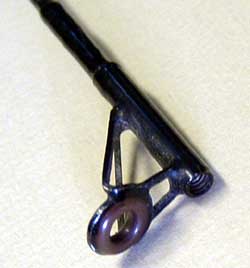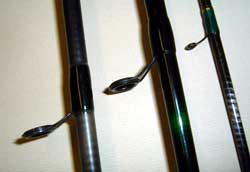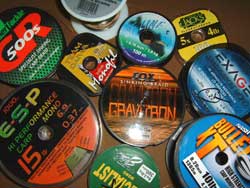Is it just me or what? Am I the only one to complain about certain developments that we are fobbed-off with nowadays? I know I am sometimes known as the ‘Marlow Moaner’ and even my family says it’s like living with ‘Meldrew’, but I feel at times that certain things have to be said and if they come across as a moan, that’s too bad.
You know what happens when you’ve just reeled in to re-bait, there’s a little slack line blowing around in the light breeze and next thing you know, it’s wrapped itself around the rod and the top rings. On rods with triple or quadruple legged rings you simply pull the line tight, twist the rod around a couple of times and the line comes free again. NOT with single-leg rings it doesn’t and the only way to free the line is to get up or pass the rod back to the top end and free the line. This causes bank disturbance and at night it is highly frustrating since you can’t see what you’re doing unless you turn on your headlight, which in turn frightens any nearby fish. There are situations where, I accept, single-leg rings must be used. For example on quivertips that are so light it would kill the sensitivity if triple legged rings were used. And on some of the finest match rod tips, the final few rings might have to be single-leg, but why on carp and barbel rods? You don’t need to worry so much with these rods about flat spots, Dick Walker never did when he designed the famous Mark IVs, because he got it right. Even on quivertips, have you ever rebaited the feeder, put a couple of new maggots on the hook, cast the whole lot out only to immediately hear the recognisable sound, a bit like a pistol shot, of the last two inches of tip shattering as it was pulled back on itself? It’s depressing (excuse the pun) when it happens and it’s another £ 15 or so on a new tip. On barbel rods, if you do the same and fail to notice a tangle you get a full 5oz of feeder and feed flying back into your face. This has annoyed me so much that I am now refusing to buy any more rods that are fitted with single-leg rings.
A couple of years ago I couldn’t wait to get my hands on the new Fox Barbel Special rod (1.5lbs) and at first it pleased me. The action was great and still is, but those damned single-leg rings mean that I now only use it during daylight hours. Even the more expensive Fox Kevlar Barbel rod has them, as does the new Greys Barbel rods, and Daiwa, and Shimano, and Chub, and,….. Everyone is fitting the damned things because they say they don’t spoil the action, they don’t cause ‘flat spots’, or that we (the anglers) asked for them! Who did?…. I didn’t, that’s for sure. In fact, I got so annoyed with them I bought what I think is the Rolls-Royce of barbel rods, the Harrison Chimera Barbel. Sure it’s a toughy, no stated test curve on it, but I get a decent enough fight out of a five-pounder and in flood conditions it’s just right. Best of all it has triple-legged rings throughout and I don’t suffer the line tangles half as much and those that I do get are usually easy to pull and twist out of. I would still like a lighter barbel rod, say around 1lb 6ozs test curve, 12 foot with a nice screw-down reel seat, triple-legged rings of course, and a keeper ring, something the Chimera also boasts. What I also don’t want is one of those stupid threaded end-rings that we are supposed to fit swing or quivertips into that get bunged up with dirt. The last time we used those was back in the 1970’s, but I suspect that the manufacturers had several million made and they’re still working through the stockpile. Come on guys, put a decent end-ring on specimen rods because if we want a quiver rod we’ll buy a quiver rod. Which brings me nicely onto the new Korum Heavy Feeder rods. Now there’s a sexy rod if ever I saw one. The handle has a curvy feminine shape that we all like to grab hold of, a screw-down reel seat, triple-leg rings except for the quiver tip (accepted), and this can be used for a lot of specimen barbel fishing. It’s absolutely gorgeous, but if they decide to make a true specimen barbel rod, 1lb 6ozs tip, triple-legged rings throughout, nice tip ring, keep ring, handle like on that Korum Heavy Feeder, let me know and I’ll write the cheque out. So let’s see some comments on the forum. Are you sick and tired of single-leg rings and if so, why? If you’re not and like them, well have you ever thought about taking up golf?
Whilst I’m ranting on about tackle I thought I would add some comments to those made in Coarse Fisherman recently about main line and hooklength strengths. It also follows on from my piece last month on ‘Do fish feel pain’ and whereas I still maintain they don’t, I did pick up on some of the cautions issued in Dr Rose’s fine report. He cautioned about fighting fish for too long as toxins build up in the muscles of the fish and can lead to it’s death. This is something we all want to avoid, but there are foolish fellows out there who don’t yet understand this. One that I chanced to meet last year was fishing for little wildies in a small lily-covered pond and after losing his third fish to line breakage I asked him what poundage line he was using. He told me 3lb since “..he wanted to give them a fighting chance.” Most of the regulars there use 5 or 6 lbs line because then we can bully the fish out and away from the lilies before they get tangled in them. His ‘fighting chance’ sport had left three fish with hooks and towing float, weights, and Heaven knows how much line around until either they shed them (he was on barbless at least, which is the rule) or someone else caught them to remove the offending material. There seems to be an argument when fishing to use the finest line you can get away with. I disagree and say use the strongest you can get the fish to accept. The last thing you really want is to play fish for too long on tackle that just isn’t up to the job, plus you really don’t want to experience the disappointment of losing a prize catch. Saying that, I do accept that a 16lbs fish doesn’t demand 16lbs line for it’s not based on the weight of the fish, but the weight it can pull. I agree also with Graham Marsden that it is okay to use hooklengths for carp up to twice the breaking strain of the main line simply because of the properties that the stronger hooklength affords us. This is because under normal circumstances most carp up to 40lbs plus would find it hard to break a line of 12lbs in a straight pull – you try it! So it would matter little that the hooklength was even stronger providing that, just in case, it wasn’t too long and that the weight can break away leaving the fish to swim around freely. Another word of caution though, re-tie your rigs regularly to avoid rotten knots.
I just wish that fishing lines could be tested by a highly reliable and independent source to give us truly accurate breaking strains and diameters that are not subject to manufacturers puff. Perhaps this is a job for the ATA or the Angling Foundation, or why not HM Weights and Measures since they are supposed to oversee all other measurements. Until then we must use our best judgement to ensure that our fish are caught and played out reasonably quickly and are put back in a condition that doesn’t leave them threatened. Note from Graham: I don’t think Jeff has seen, or heard of, the FISHINGmagic Concept rod, designed by FISHINGmagic members and made by Harrisons. Sounds to me like it is exactly what he’s looking for. Get the cheque book out Jeff! The FISHINGmagic.com Concept rod. |
Welcome!Log into your account














